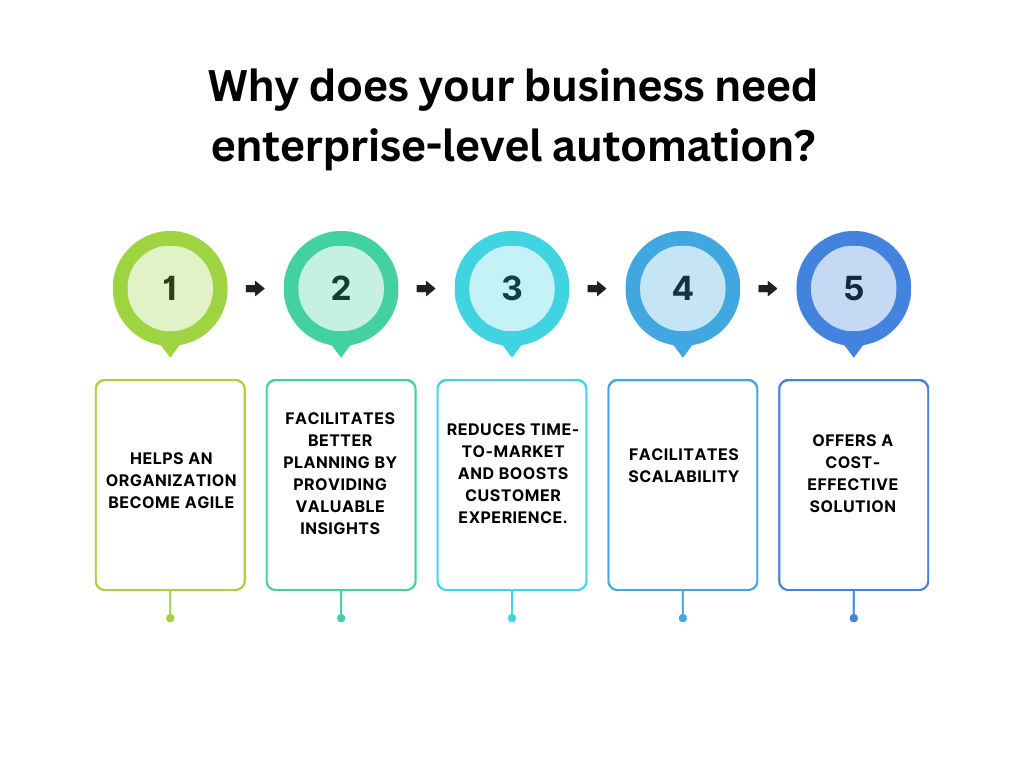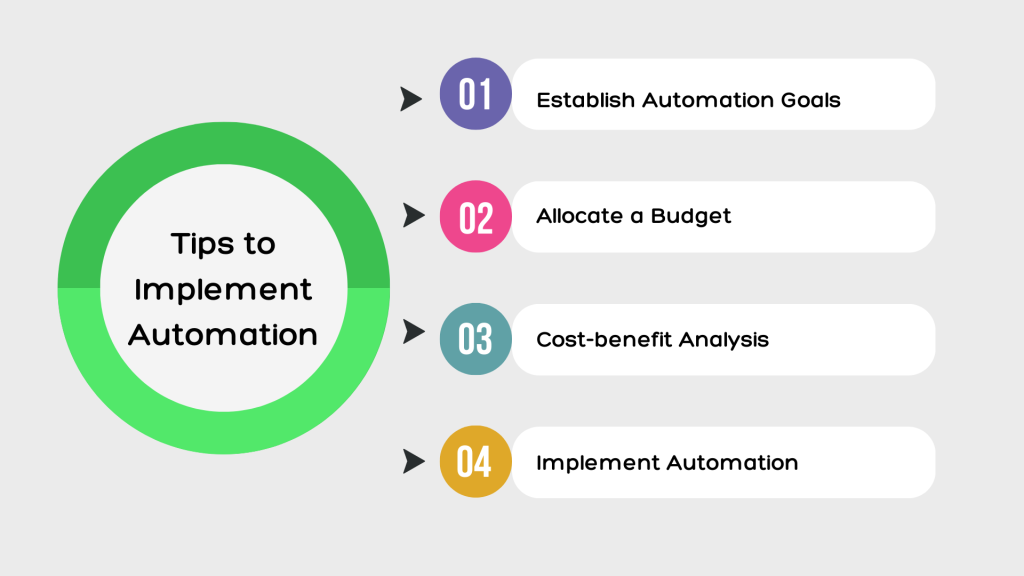
Key takeways
- Enterprise-level automation is leveraging automation across the organization to minimize the cost and inefficiencies of manual processes.
- Enterprise-level automation leverages RPA to automate rule-based processes. AI and ML are used to make intelligent decisions backed by data.
- Enterprise-level automation can disrupt the way legacy systems function.
- In addition to technological interventions, human resource planning is a vital element of the digital transformation initiatives of an organization.
The COVID-19 pandemic has caused major disruptions in the manner in which businesses function. The shortcomings of legacy systems were exposed during the pandemic. The organizations that had taken the digital transformation route were able to cope with the disruptions to a large extent. However, those that had not adopted digital methods struggled to manage.
Businesses have now understood the importance of digital transformation and accelerated the pace of adopting innovative technologies. Digital transformation entails adopting methods and technologies that overcome the challenges of legacy systems and enhance efficiency.
Some of the technologies spearheading the change to a digital-first approach are the Cloud, Robotic Process Automation (RPA), Artificial Intelligence (AI), Machine Learning (ML), Big Data, and more.
Until a few years ago, businesses were adopting automation technologies to automate specific processes like invoice processing, supply-chain management, etc. No doubt these technologies enhanced the efficiency of specific processes but the coordination between a mix of automated and manual processes led to other issues.
The solution for managing several disparate systems is integrating them with enterprise-level automation.
Enterprise-level automation is a vital part of an organization’s digital transformation journey. Data reveals that 97% of organizations believe that business automation is crucial for digital transformation. (Source: Imaginovation)
What is Enterprise-level Automation?
Enterprise-level automation is leveraging automation across the organization to minimize the cost and inefficiencies of manual processes. It automates business functions across the value chain of the business. It also automates IT functions, and processes like application engineering, operations, and security.
Automation of business processes and workflow automation optimizes costs and enhances efficiency. An integrated automation approach provides sustainable benefits to the organization.
Enterprise-level automation entails automating various logic-based processes with RPA. The software for automating different processes facilitates the interplay of different processes as and when required. Technologies like AI and ML are leveraged to make automation capable of making intelligent decisions.
Why does an Organization need Enterprise-level Automation?
1. Agility
Automation makes an organization agile. The organization is capable of responding quickly to any external or internal changes. AI-based automation extracts and analyzes data accurately. AI analyzes any data pertaining to changes in market conditions or customer demands and provides valuable insights to the professionals to take the required action.
2. Better Planning
One of the most essential factors for an organization to make accurate decisions is data. Processing large volumes of data is difficult through manual methods. AI gathers relevant data and analyzes it accurately. Also, the predictive analytic ability of AI helps make accurate business forecasts. All this information enables business professionals to manage demand-supply, logistics, inventory management, and more.
3. Minimizes Time-to-Market
Automation of different processes with the help of RPA bots is an integral part of enterprise-level automation. Automation of processes increases the speed of processes and reduces time to market thereby enhancing customer experience.
RPA bots also eliminate human errors in processes and help provide better outcomes for processes. It is because of these benefits that businesses are choosing automation solutions for their enterprises. Research indicates that the RPA market which was at USD 1.4 billion is expected to grow at a CAGR of 6% between 2020 and 2027. (Source: Imaginovation)
4. Scalability
A business becomes more complex as it grows. This is because its growth increases manpower requirements, documentation, data management needs, and more. In legacy systems, managing these complexities can slow down the growth of the business. Automated systems offer scalability because the software bots can easily be programmed to manage the increased needs of the business.
5. Streamlines Processes
Automating different processes without integration causes complications and the organization will be unable to reap the benefits of automation. A single platform that supports different processes across the organization makes the journey of digital transformation seamless.
6. Cost-effective
A consolidated enterprise-level automation solution proves to be a cost-effective solution when compared with the automation of individual processes using different automation platforms.
Besides these, enterprise-level automation offers benefits like high accuracy, reduced process times, increased efficiency, and productivity.
Implementing enterprise-level automation can cause a major disruption in the manner in which the business functions. Hence, it must be planned carefully.

Here are a few tips to prepare the roadmap for your enterprise-level automation
1. Establish Goals
Define what exactly you expect to achieve by adopting enterprise-level automation. Ascertain the benefits automation will offer your business. Make sure you make an assessment bearing the long-term needs and future growth prospects of your business in mind. Assess your processes and identify opportunities for automation.
2. Allocate a Budget
Automation is expensive. Hence it is recommended that you allocate a budget for the cost of enterprise-level automation.
3. Cost-benefit Analysis
Before you make any kind of investment, you need to carry out a cost-benefit analysis to assess if the expected returns justify the expenses incurred. Make sure that automation can boost your ROI in the long run.
One way to measure automation efficiency is to establish target metrics you want to improve and methods to track improvement. Auxiliobits automation software includes data visualization tools that link directly to the deployed processes.
The high costs of automation may deter you but you must bear in mind that it is a futuristic technology and provides long-term benefits. Although the initial investment may be high, the long-term benefits justify the costs.
4. Choose the Right Automation Software
There is a myriad of automation solutions available in the market and it can be confusing to differentiate between them. It is worthwhile to invest your time to understand the features and capability of each platform before you choose one. Also, you must select software that integrates with your existing systems seamlessly. Make sure that you choose the automation software that is aligned with your business goals.
It is a good idea to consult the representative of an automation service provider to understand the features and workings of their software. Auxiliobits has a team of experienced professionals who can guide you choose the best automation software for your business. We provide enterprise-level automation solutions tailored to the needs of your organization.
5. Implement Automation
Implementing enterprise-level automation will cause major disruptions in your organization. So, before implementing automation make sure that you are aware of the processes that will be automated, the tools and technologies that will be used, etc. Automation tools are a combination of robotic process automation, workflow automation, data analytics, machine learning software, cloud services, and more.

The top leadership must be aware of the disruptions that will be caused by implementing automation and plan well in advance for hassle-free digital transformation. One of the focus areas is to allay the fear of internal teams that automation bots will not take away their jobs but will support them to enhance the efficacy of the systems.
Human resource planning is an important element of the digital transformation initiatives of an organization. According to a global survey, 74% of the respondents quoted that their workforce (11% to 50%) would be impacted by the adoption of AI-based automation. (Source: Imaginovation). You will need to assess the changes in human resource planning that will be required as a consequence of automation. This is because the automation of several processes will relieve employees of routine tasks. Hence, you might need to assign different roles to employees. You may also need to train employees to perform new tasks. Ensure that you have an in-house team that can work collaboratively with automation bots to provide the required outcomes.
Make sure that you have the required infrastructure to host enterprise-level automation.
Final Takeaway
The ultimate objective of any organization is enhancing customer experience. Managing a variety of functions while ensuring that you meet customer demands can be challenging. Enterprise-level automation ensures that all processes function seamlessly in tandem so that business leaders can focus on the growth of the business.
The right automation service provider will make sure that the integration of automation does not cause too many disruptions. Automation consultants at Auxiliobits work with your team to build a roadmap for the seamless integration of enterprise-level automation for your organization.
Call us Now to build an effective enterprise-level automation strategy for your business!






